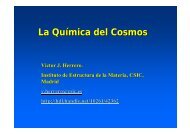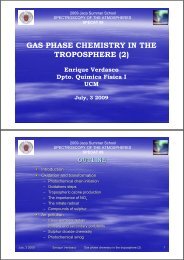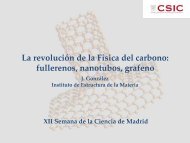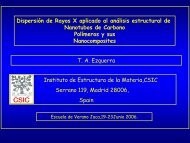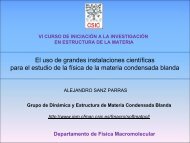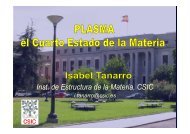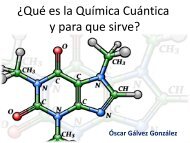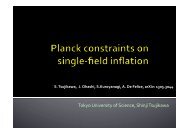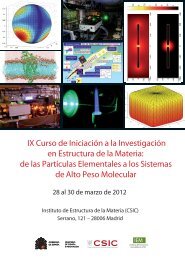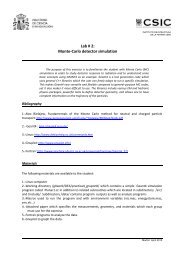ANNUAL REPORT 2011 - Instituto de Estructura de la Materia
ANNUAL REPORT 2011 - Instituto de Estructura de la Materia
ANNUAL REPORT 2011 - Instituto de Estructura de la Materia
Create successful ePaper yourself
Turn your PDF publications into a flip-book with our unique Google optimized e-Paper software.
Nanostructure of polymer thin films.Polymer nanocomposites: Structure and physical properties.Confined structure and dynamics in Soft Matter.Conformation of biological Soft Matter: Membrane protein solutions.Micro<strong>de</strong>formation processes, re<strong>la</strong>tion to the nanostructure and optimization of the mechanichal properties.Early stages of polymer crystallization un<strong>de</strong>r shear <strong>de</strong>formation.Nanostructure of multi<strong>la</strong>yer materials by means of Ultra Small Angle X-ray scattering.Structure <strong>de</strong>velopment and properties of natural polymers and nanocomposites.Recrystallization processes in semirigid systems.Pre-crystallization phenomena, crystallization and phase transitions in synthetic and natural polymers.Synthesis of funcionalized polyolefins.Study of polimerization reaction by quantum mechanical calcu<strong>la</strong>tion.Hierarchical simu<strong>la</strong>tion of molecu<strong>la</strong>r dynamics.New polyolefins with controlled architecture: structure and properties.Molecu<strong>la</strong>r dynamics and viscoe<strong>la</strong>stic properties.Extrusion and elongational processes in polyolefin blends.Molecu<strong>la</strong>r dynamics and dielectric properties.Structure-dynamics -re<strong>la</strong>tionships in soft and polymeric con<strong>de</strong>nsed matter.Tridimensional electron microscopy: Structural study of biological macromolecules.Hydrodynamics of proteins and biological macromolecu<strong>la</strong>r complexes.Biophysics.EMPLOYED TECHNIQUES:ooooooooooooooooooScattering and diffraction of X-rays at Wi<strong>de</strong> (WAXS), Small (SAXS), and Ultra-Small (USAXS) Anglesand with grazing inci<strong>de</strong>nte (GISAXS) including micro- and nano-beam with synchrotron radiation.Scanning Diferential Calorimetry.Incoherent quasie<strong>la</strong>stic neutron scattering.Optical microscopy. Scanning electronic microscopy.Raman Spectroscopy.Micro and nano hardness.Neutron Scattering.Broad band dielectric spectroscopy.Shear rheometry in continuous dynamic torsion.Capi<strong>la</strong>r extrusion and elongational rheometry.Dynamic mechanical analysis un<strong>de</strong>r flexural <strong>de</strong>formation.Dynamic mechanical analysis un<strong>de</strong>r tensile <strong>de</strong>formation: e<strong>la</strong>stic modulus.Analysis by crystallization temperature fractionation (CRYSTAF).Scanning/transmision electron (STEM) and atomic force (AFM) microscopies.Size exclusion chromatography (SEC) and and tetra<strong>de</strong>tection.Dynamic light scattering (DLS).Nanoimprint lithography (NIL).X Photon Corre<strong>la</strong>tion Spectroscopy (XPCS).RESEARCH ACTIVITY:Group of PHYSICAL PROPERTIES AND NANOSTRUCTURE OF POLYMERSINFLUENCE OF ADDITIVES ON THE NANOSTRUCTURE OFBENTONITE REINFORCED PVCThe nanostructure of 5% bentonite reinforced polyvinyl chlori<strong>de</strong> (PVC) was investigated by means of wi<strong>de</strong> angle X-ray diffraction measurements and results were corre<strong>la</strong>ted to the mechanical properties studied un<strong>de</strong>r uniaxial tension.Results showed that the morphology, nanostructure and mechanical properties were influenced by the sort ofadditive ad<strong>de</strong>d to the nanocomposites (a f<strong>la</strong>me retardant or a pigment dispersant). It was found that the f<strong>la</strong>meretardant additive promoted polymer interca<strong>la</strong>tion and significantly reduced the material roughness. In this case, thenanop<strong>la</strong>tes were arranged parallel to the surface of the mol<strong>de</strong>d sheets and this orientation was preserved upon colddrawing.Young’s modulus and yield stress increased significantly for this nanocomposite while strain at failure wasslightly reduced, re<strong>la</strong>tive to the neat PVC. On the other hand, the pigment dispersant additive was found to promotenanoc<strong>la</strong>y exfoliation, the polymer matrix showing isotropic orientation. Moreover, the addition of c<strong>la</strong>y did notenhance the tensile mechanical properties with respect to the control PVC; the strain at failure was even significantly72




